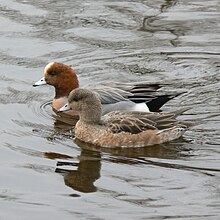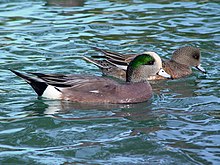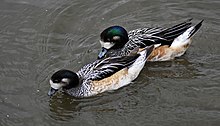| Wigeons | |
|---|---|

| |
| Male (rear) and female (front) Eurasian wigeons. | |
| Eurasian wigeon calls recorded in Dorset, England | |
|
Scientific classification
| |
| Domain: | Eukaryota |
| Kingdom: | Animalia |
| Phylum: | Chordata |
| Class: | Aves |
| Order: | Anseriformes |
| Family: | Anatidae |
| Tribe: | Anatini |
| Genus: | Mareca |
| Species | |
The wigeons or widgeons are a group of birds, dabbling ducks currently classified in the genus Mareca along with two other species. There are three extant species of wigeon, in addition to one recently extinct species.
Biology


There are three extant species: the Eurasian wigeon (Mareca penelope), the American wigeon (M. americana) and the Chiloé wigeon (M. sibilatrix). A fourth species, the Amsterdam wigeon (Mareca marecula), became extinct in the 19th century. The wigeons' closest relatives, forming with them the genus Mareca, are the gadwall and the falcated duck. [1] [2]
All three wigeons are similarly shaped, with a steep forehead and bulbous rear to the head. All three wigeon species hybridise in captivity [3] while American and Eurasian wigeons hybridise in the wild. [4] An American wigeon × mallard hybrid has also been recorded. [5]
The American wigeon was formerly called the baldpate by ornithologists, and some people still use that name, especially hunters.
The diet of the wigeon consists mainly of grass leaves (~80%), other food types eaten are seeds (~10%) and roots and stems (~5%). [6]
References
- ^ Johnson, KP; Sorenson, MD (1999). "Phylogeny and biogeography of dabbling ducks (genus: Anas): A comparison of molecular and morphological evidence" (PDF). The Auk. 116 (3): 792–805. doi: 10.2307/4089339. JSTOR 4089339.
- ^ Gonzalez, J.; Düttmann, H.; Wink, M. (2009). "Phylogenetic relationships based on two mitochondrial genes and hybridization patterns in Anatidae". Journal of Zoology. 279 (3): 310–318. doi: 10.1111/j.1469-7998.2009.00622.x.
- ^ Jiguet, Frédéric (1999). "Photo-forum: hybrid American Wigeons". Birding World. 12 (6): 247–52.
- ^ Carey, Geoff J. (1993). Hybrid male wigeon in East Asia Hong Kong Bird Report 1992 160-6
- ^ Fedynich, Alan M. & Rhodes, Olin E. Jr. (1993). "Mallard × American Wigeon Hybrid on the Southern High Plains of Texas". The Southwestern Naturalist. 38 (2): 179–181. doi: 10.2307/3672079. JSTOR 3672079.
- ^ Owen, Myrfyn; Thomas, G. J. (1979-01-01). "The Feeding Ecology and Conservation of Wigeon Wintering at the Ouse Washes, England". Journal of Applied Ecology. 16 (3): 795–809. doi: 10.2307/2402854. JSTOR 2402854.
Further reading
- Bailey HH (1919). "An interesting hybrid of Mareca penelope (Widgon) and Mareca americana (Baldpate)". Wilson Bulletin. 31: 25.
- Cox C, Jessie B. "Aging of American and Eurasian Wigeons in female-type plumages" (PDF). Birding. 37 (2): 156–164.
- Harrison JM, Harrison JG (1968). "Wigeon × Chiloé Wigeon hybrid resembling American Wigeon". British Birds. 61: 169–171.
- Harrop A (1994). "Photo-forum: a presumed hybrid American Wigeon in Grampian". Birding World. 7: 116–7.
- Harrop A (1994). "Field identification of American Wigeon". Birding World. 7: 50–56.
- Jiquet F (1999). "Photo forum: Hybrid American Wigeons". Birding World. 12: 247–252.
- Larkin P (2000). "Eyelid colour of American Wigeon". British Birds. 93: 39–40.
- MacKay A (1996). "Hybrid wigeon resembling American Wigeon in Leicestershire". Birding World. 9: 146–7.
- Shiota T (1987). "A challenge in the identification of hybrid American and Eurasian Wigeon". Yacho. 496: 6, 18–19.
- Votier SC, Harrop AH, Denny M (2003). "A review of status and identification of American Wigeon in Britain and Ireland". British Birds. 96: 2–22.
- Watson GE (1970). "A presumed wild hybrid Baldpate × Eurasian Wigeon". The Auk. 87 (2): 353–7. doi: 10.2307/4083926. JSTOR 4083926.
External links
Photographs of hybrid wigeons can be seen here and here.
| Wigeons | |
|---|---|

| |
| Male (rear) and female (front) Eurasian wigeons. | |
| Eurasian wigeon calls recorded in Dorset, England | |
|
Scientific classification
| |
| Domain: | Eukaryota |
| Kingdom: | Animalia |
| Phylum: | Chordata |
| Class: | Aves |
| Order: | Anseriformes |
| Family: | Anatidae |
| Tribe: | Anatini |
| Genus: | Mareca |
| Species | |
The wigeons or widgeons are a group of birds, dabbling ducks currently classified in the genus Mareca along with two other species. There are three extant species of wigeon, in addition to one recently extinct species.
Biology


There are three extant species: the Eurasian wigeon (Mareca penelope), the American wigeon (M. americana) and the Chiloé wigeon (M. sibilatrix). A fourth species, the Amsterdam wigeon (Mareca marecula), became extinct in the 19th century. The wigeons' closest relatives, forming with them the genus Mareca, are the gadwall and the falcated duck. [1] [2]
All three wigeons are similarly shaped, with a steep forehead and bulbous rear to the head. All three wigeon species hybridise in captivity [3] while American and Eurasian wigeons hybridise in the wild. [4] An American wigeon × mallard hybrid has also been recorded. [5]
The American wigeon was formerly called the baldpate by ornithologists, and some people still use that name, especially hunters.
The diet of the wigeon consists mainly of grass leaves (~80%), other food types eaten are seeds (~10%) and roots and stems (~5%). [6]
References
- ^ Johnson, KP; Sorenson, MD (1999). "Phylogeny and biogeography of dabbling ducks (genus: Anas): A comparison of molecular and morphological evidence" (PDF). The Auk. 116 (3): 792–805. doi: 10.2307/4089339. JSTOR 4089339.
- ^ Gonzalez, J.; Düttmann, H.; Wink, M. (2009). "Phylogenetic relationships based on two mitochondrial genes and hybridization patterns in Anatidae". Journal of Zoology. 279 (3): 310–318. doi: 10.1111/j.1469-7998.2009.00622.x.
- ^ Jiguet, Frédéric (1999). "Photo-forum: hybrid American Wigeons". Birding World. 12 (6): 247–52.
- ^ Carey, Geoff J. (1993). Hybrid male wigeon in East Asia Hong Kong Bird Report 1992 160-6
- ^ Fedynich, Alan M. & Rhodes, Olin E. Jr. (1993). "Mallard × American Wigeon Hybrid on the Southern High Plains of Texas". The Southwestern Naturalist. 38 (2): 179–181. doi: 10.2307/3672079. JSTOR 3672079.
- ^ Owen, Myrfyn; Thomas, G. J. (1979-01-01). "The Feeding Ecology and Conservation of Wigeon Wintering at the Ouse Washes, England". Journal of Applied Ecology. 16 (3): 795–809. doi: 10.2307/2402854. JSTOR 2402854.
Further reading
- Bailey HH (1919). "An interesting hybrid of Mareca penelope (Widgon) and Mareca americana (Baldpate)". Wilson Bulletin. 31: 25.
- Cox C, Jessie B. "Aging of American and Eurasian Wigeons in female-type plumages" (PDF). Birding. 37 (2): 156–164.
- Harrison JM, Harrison JG (1968). "Wigeon × Chiloé Wigeon hybrid resembling American Wigeon". British Birds. 61: 169–171.
- Harrop A (1994). "Photo-forum: a presumed hybrid American Wigeon in Grampian". Birding World. 7: 116–7.
- Harrop A (1994). "Field identification of American Wigeon". Birding World. 7: 50–56.
- Jiquet F (1999). "Photo forum: Hybrid American Wigeons". Birding World. 12: 247–252.
- Larkin P (2000). "Eyelid colour of American Wigeon". British Birds. 93: 39–40.
- MacKay A (1996). "Hybrid wigeon resembling American Wigeon in Leicestershire". Birding World. 9: 146–7.
- Shiota T (1987). "A challenge in the identification of hybrid American and Eurasian Wigeon". Yacho. 496: 6, 18–19.
- Votier SC, Harrop AH, Denny M (2003). "A review of status and identification of American Wigeon in Britain and Ireland". British Birds. 96: 2–22.
- Watson GE (1970). "A presumed wild hybrid Baldpate × Eurasian Wigeon". The Auk. 87 (2): 353–7. doi: 10.2307/4083926. JSTOR 4083926.
External links
Photographs of hybrid wigeons can be seen here and here.